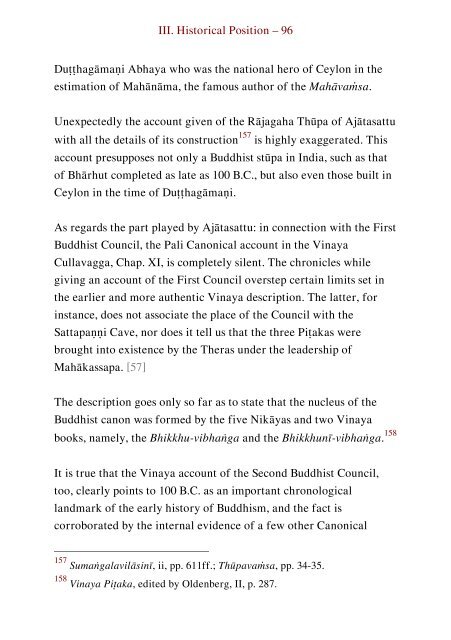On the Chronicles of Ceylon
A judicious appraisal of the various Chronicles that were written in Sri Lanka, assessing their chronology, literary and historical character.
A judicious appraisal of the various Chronicles that were written in Sri Lanka, assessing their chronology, literary and historical character.
- No tags were found...
Create successful ePaper yourself
Turn your PDF publications into a flip-book with our unique Google optimized e-Paper software.
III. Historical Position – 96<br />
Duṭṭhagāmaṇi Abhaya who was <strong>the</strong> national hero <strong>of</strong> <strong>Ceylon</strong> in <strong>the</strong><br />
estimation <strong>of</strong> Mahānāma, <strong>the</strong> famous author <strong>of</strong> <strong>the</strong> Mahāvaṁsa.<br />
Unexpectedly <strong>the</strong> account given <strong>of</strong> <strong>the</strong> Rājagaha Thūpa <strong>of</strong> Ajātasattu<br />
with all <strong>the</strong> details <strong>of</strong> its construction 157 is highly exaggerated. This<br />
account presupposes not only a Buddhist stūpa in India, such as that<br />
<strong>of</strong> Bhārhut completed as late as 100 B.C., but also even those built in<br />
<strong>Ceylon</strong> in <strong>the</strong> time <strong>of</strong> Duṭṭhagāmaṇi.<br />
As regards <strong>the</strong> part played by Ajātasattu: in connection with <strong>the</strong> First<br />
Buddhist Council, <strong>the</strong> Pali Canonical account in <strong>the</strong> Vinaya<br />
Cullavagga, Chap. XI, is completely silent. The chronicles while<br />
giving an account <strong>of</strong> <strong>the</strong> First Council overstep certain limits set in<br />
<strong>the</strong> earlier and more au<strong>the</strong>ntic Vinaya description. The latter, for<br />
instance, does not associate <strong>the</strong> place <strong>of</strong> <strong>the</strong> Council with <strong>the</strong><br />
Sattapaṇṇi Cave, nor does it tell us that <strong>the</strong> three Piṭakas were<br />
brought into existence by <strong>the</strong> Theras under <strong>the</strong> leadership <strong>of</strong><br />
Mahākassapa. [57]<br />
The description goes only so far as to state that <strong>the</strong> nucleus <strong>of</strong> <strong>the</strong><br />
Buddhist canon was formed by <strong>the</strong> five Nikāyas and two Vinaya<br />
books, namely, <strong>the</strong> Bhikkhu-vibhaṅga and <strong>the</strong> Bhikkhunī-vibhaṅga. 158<br />
It is true that <strong>the</strong> Vinaya account <strong>of</strong> <strong>the</strong> Second Buddhist Council,<br />
too, clearly points to 100 B.C. as an important chronological<br />
landmark <strong>of</strong> <strong>the</strong> early history <strong>of</strong> Buddhism, and <strong>the</strong> fact is<br />
corroborated by <strong>the</strong> internal evidence <strong>of</strong> a few o<strong>the</strong>r Canonical<br />
157 Sumaṅgalavilāsinī, ii, pp. 611ff.; Thūpavaṁsa, pp. 34-35.<br />
158 Vinaya Piṭaka, edited by Oldenberg, II, p. 287.


















